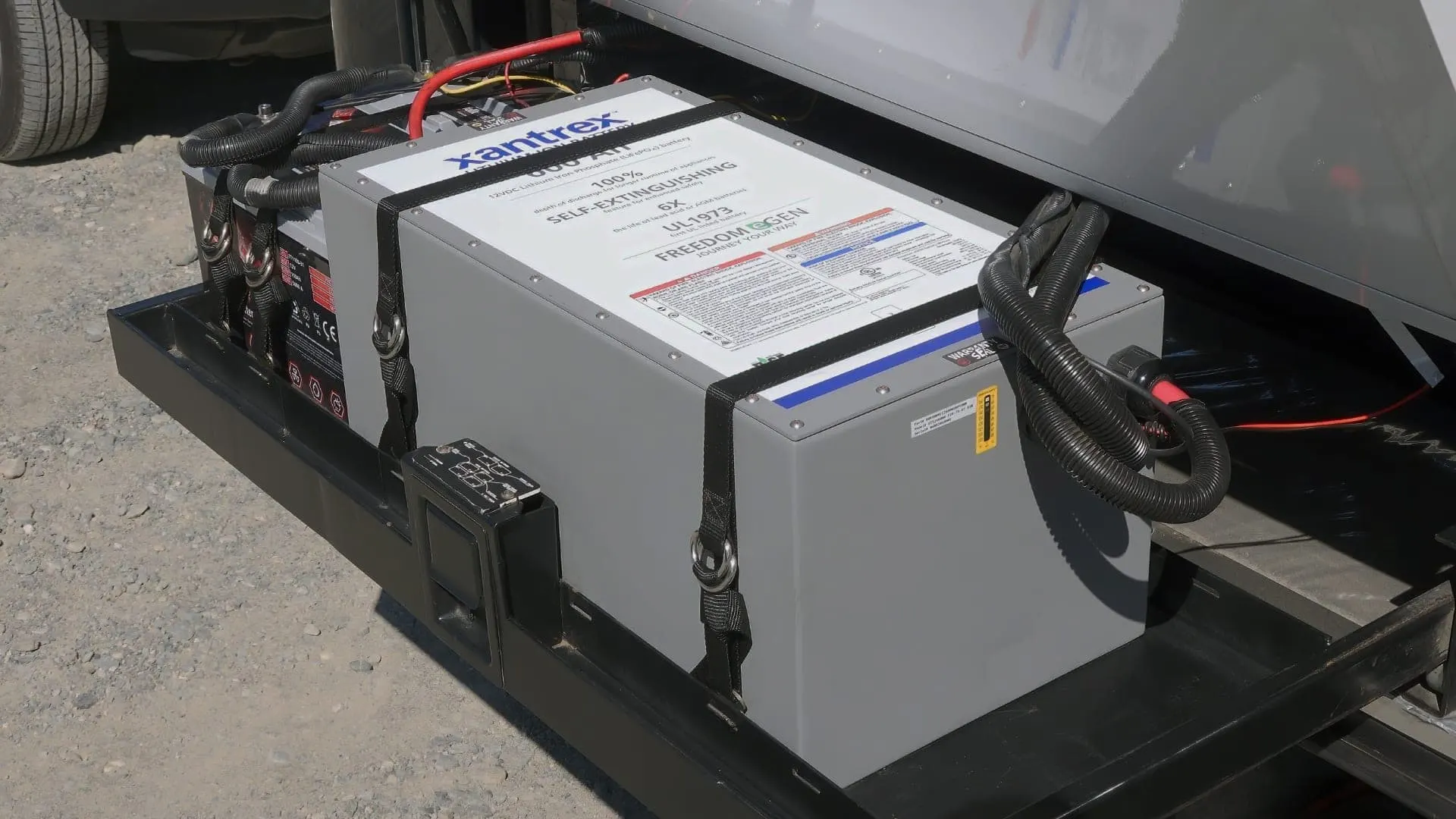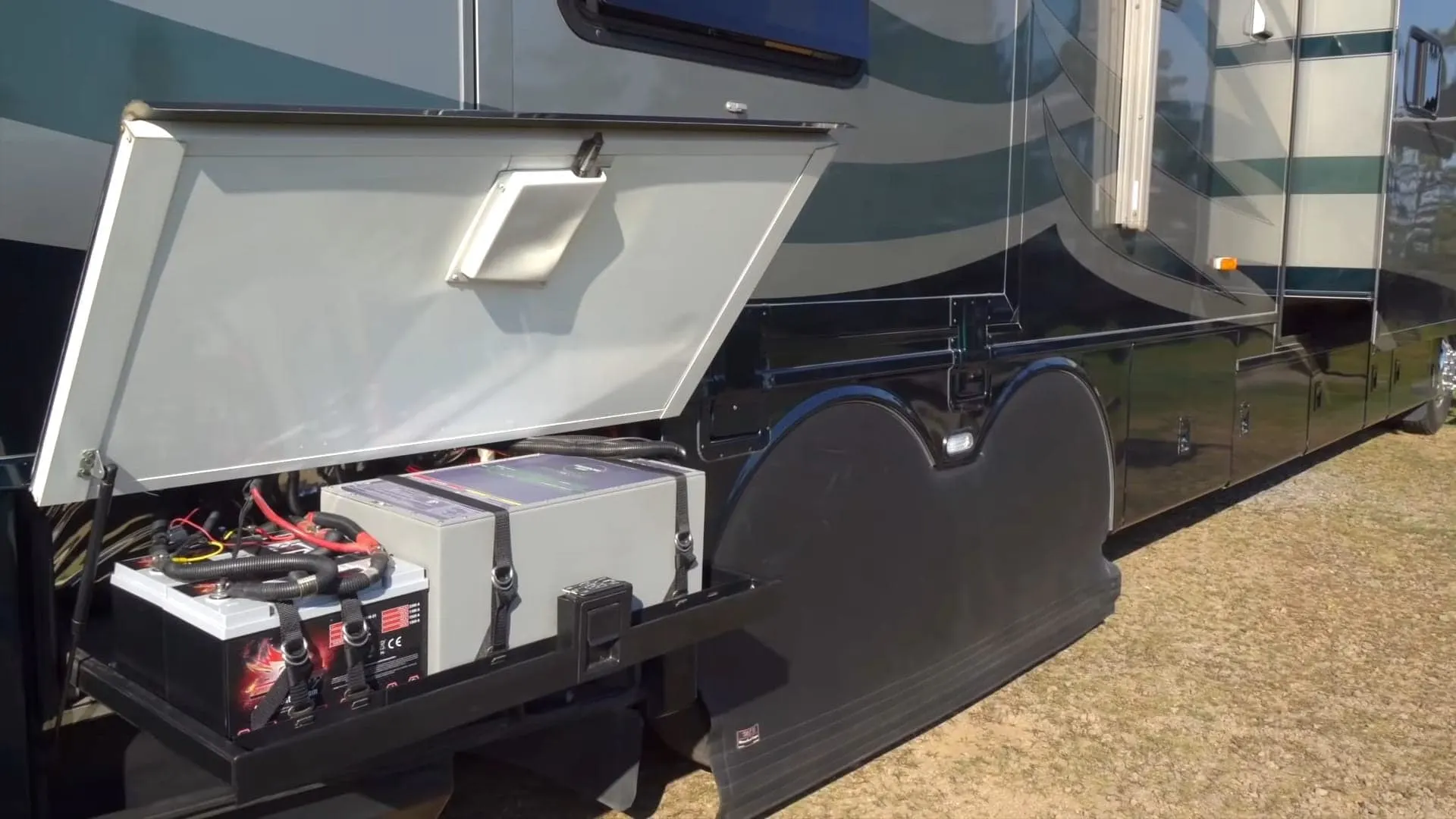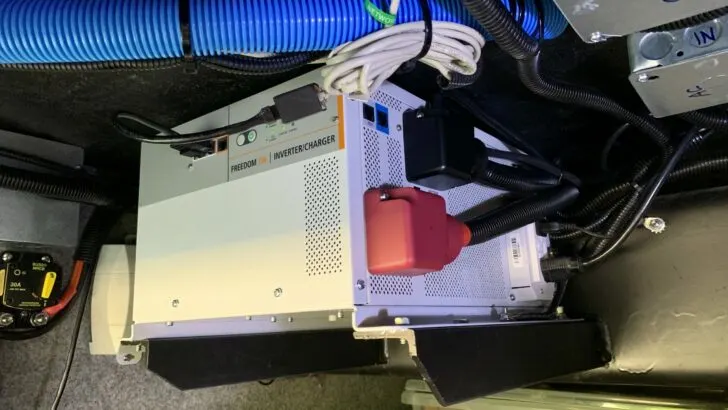So you love RV travel and especially enjoy camping off the grid… but you ALSO love your modern electrical conveniences. You work on a computer. You like to use a coffee maker in the morning or a microwave to warm up something for dinner. Or it’s raining hard outside and binge-watching a few episodes of Queen’s Gambit is on the agenda. Meanwhile, your teenagers make your leisurely evenings miserable if they don’t have access to their Xbox. Enter your friend, the RV inverter.
- 1) What is an RV Inverter?
- 2) How Does an RV Inverter Work?
- 3) Difference Between an RV Inverter and RV Converter
- 4) Pure Sine Wave vs Modified Sine Wave
- 5) How to Use an RV Inverter
- 6) Should I Leave My RV Inverter On All the Time?
- 7) What Size Inverter Do I Need for My RV?
- 8) Is an RV Inverter Worth It?
- 9) Conclusion
What is an RV Inverter?
Many appliances and devices require 120V AC power. When your RV is plugged into shore power, you’re bringing a source of 120V AC electricity into your RV to power those appliances and devices, just as if you were at home.
But the battery/batteries in your RV provide 12V DC power. So, when the source of your RV’s power is a battery bank, as it is when you’re boondocking, you need an inverter to change the 12V DC electricity from your RV’s batteries to 120V AC electricity for use with your 120V appliances.
Otherwise, you’re going to have to run your generator to power those devices. Which, don’t get us wrong, is perfectly fine and what a lot of RV owners choose to do. Especially if your need for 120V AC power is limited.
But if you need AC power more often (if you work from the road, for example) and/or if you’d rather not hear the drone of a generator for long periods of time, an RV inverter is your only option.
How Does an RV Inverter Work?
DC (direct current) is constant, while AC (alternating current) cycles up and down from +120V to -120V and back. A power inverter takes 12V direct current and converts it to 120V alternating current by first increasing the voltage and then modifying it so that it alternates. In other words, an inverter boosts your 12V direct current power supply to a 120V alternating current power supply.

An RV inverter takes the 12V power from your battery bank and changes it to 120V power capable of powering appliances like TVs, computers, and coffee makers.
In addition to that, higher-end inverters include bypass circuitry. This way, when you’re connected to shore power, they go into “Standby Mode” and stop pulling power from your batteries, instead allowing the shore power to flow directly through to the circuits.
Some even more sophisticated inverters offer a feature that’s known as “Hybrid” or “Power Assist” functionality. These type of inverters can augment the supply of shore power (or a generator) if the load/demand exceeds the supply, temporarily taking power from the batteries and converting it to 120V electricity that’s in perfect phase with the incoming power supply.
- Victron Energy Multiplus is a powerful compact 12-Volt 3000VA 120 amp 120V true sine wave inverter and a sophisticated battery charger with adaptive...
- With the unique Power Assist feature Victron Energy MultiPlus will prevent overload of a limited AC source, such as a generator or shore power...
On other models, the inverter can instead entirely take over the loads on the circuits it powers, thereby reducing the power required from either the shore connection or your generator. This is the way our Xantrex Freedom SW inverter works (they call it “Generator Support Mode”, but it works with both the generator and shore power). It can sense the load being pulled by the devices it’s powering, and when that draw exceeds a user-selectable limit, it can switch to “invert” mode, removing those loads from the draw on shore/generator.
- Your purchase includes One Xantrex Freedom SW Series 815-3012 Inverter & Charger and one battery temperature sensor
- Inverter dimensions – 7.75” H x 13.5" W x 15.25" L | Product weight – 73.7 lbs. | No load Power draw (Inverting) – 3 Adc | Output wave form...
Either way your inverter works, whether it’s a “Hybrid” or “Generator Support” model, this feature can help prevent the pedestal breaker from tripping when you forget that you have the air conditioner and electric water heater running while on a 30-amp hookup and run the microwave to heat up your lunch. By either augmenting the available power (hybrid) or taking over the power of some of the RVs circuits (generator support), you can happily enjoy your now-hot meal!
Difference Between an RV Inverter and RV Converter
A lot of people don’t understand the difference between an INverter and a CONverter. The simplest explanation is that they are the direct opposite of one another. They each change the properties of electricity that passes through them… but in exactly opposite ways.
- RV inverter: takes 12V DC power and changes it to 120V AC power, allowing you to use your RV’s batteries to power 120V appliances like a microwave oven, television, or the charging brick for your laptop computer.
- RV Converter: does the reverse… it takes 120V AC power and changes it to 12V DC power to supply onboard devices such as lights, fans, slide motors, and your water pump.
To make matters even more confusing, modern converters are often battery chargers as well (hence the term “converter/charger”). This means that they not only supply 12V DC power to your RV’s onboard systems (often being able to do this whether there’s a battery in the system or not), but they can also replenish the power in your RV’s batteries (recharge them) using an appropriate charging cycle designed for the type/chemistry of your battery(ies).
An RV may even come with a combination inverter/charger (like ours) that serves both functions in one box. There are pros and cons to this design. While the ability of one box to serve two functions means there’s less equipment to install and maintain, a single unit means there could be a single point of failure. So, if your combination inverter/charger fails, you may lose both your inverter and your charger/converter at the same time.
Pure Sine Wave vs Modified Sine Wave
There are two different types of RV inverters – pure sine wave and modified sine wave. The main differences between them are efficiency and cost.
A pure sine wave inverter provides power that is exactly the same as the 120V AC power that comes out of the outlets in your house, and it’s the type of power that all 120V appliances and electronics are designed to use. They’re more efficient than modified sine wave inverters, but they’re also more expensive (though the price difference has been steadily decreasing over time).
A modified sine wave inverter doesn’t provide an exact replica of AC power, so the power produced is less “pure” which can sometimes result in interference or even failure of your devices. So, while modified sine wave inverters are less expensive, they can be harder on electronics which can, over time, cause damage to the device being powered.

Modified sine wave power has sharper cutoffs and more abrupt changes in power than pure sine wave power does.
Heated blankets and mattress pad controls, for example, seem to be particularly susceptible to failure when being run on modified sine wave power. And if you’re using a modified sine wave inverter, you may notice that power supplies (“wall warts”) can buzz and get warm or even hot.
If your RV came with a modified sine wave inverter, don’t worry. It will work as intended and provide 120V to the devices you need it to power. But if it ever fails, you may want to consider upgrading it to a pure sine model.
How to Use an RV Inverter
You’ll likely have one of a few different types of inverters, but no matter what type you have, the inverter is unlikely to supply power to everything on board the RV. What it does power depends on how the manufacturer wired your rig.
In the simplest situation, the inverter isn’t built into the RV at all and is, instead, a portable unit that plugs into the cigarette lighter. These units are typically low power (200-400 Watts) and offer one or two 120V AC outlets that you can plug devices directly into. They’re a great option for any RV that didn’t come from the factory with an inverter and/or for people who only need a few small devices to be powered (like charging a laptop).
- Portable power for AC products rated up to 450 watts
- Two GFCI receptacles for connecting multiple loads
With a portable inverter, you simply plug the inverter into the 12V socket, turn it on, and then plug whatever device you need to power with 120V AC, keeping in mind that portable inverters generally have a smaller capacity, meaning you can’t run large appliances with them.
If your RV came from the factory with an inverter installed, it’s already connected directly to the 12V battery bank and should have a control panel somewhere inside the RV so you can turn it on/off. What that RV inverter powers can vary.
In some cases, your RV may have come with a smaller inverter that’s more similar in capacity to a portable model (300-750 Watts). If so, it may be wired so that it only supplies power to a single outlet to run just the TV and DVD player, or perhaps a CPAP machine, or to charge a laptop computer.
In other cases, your RV’s inverter may be wired to a dedicated circuit breaker box (like ours is) that handles certain circuits such as the TV, microwave, and all (or some) of the outlets, but NOT high-power-draw appliances such as the air conditioner(s), washer/dryer, or the electric side of your RV refrigerator or water heater.
Rarely, likely as a result of an aftermarket installation, your RV inverter may be wired to supply your entire RV with 120V AC power. In this case, you’d need to be especially careful not to overload the inverter by running too many appliances at once, paying particular attention to higher-draw appliances, especially air conditioners and heat-generating devices like a 120V water heater or the 120V heating element of an RV refrigerator. And, of course, you need to be aware of the capacity of your battery bank to be sure you don’t run a device that will drain your batteries too quickly.
Should I Leave My RV Inverter On All the Time?
Typically, it’s not necessary to leave an RV inverter on all of the time. The inverter does draw some power on its own (even with nothing plugged into it), so you won’t generally want to leave it on when it isn’t needed to supply power.
However, if you have a residential refrigerator in your RV, then YES – you likely want to leave your inverter on all the time. Some high-end RVs come with a separate, smaller inverter that’s dedicated to the fridge, but in most cases with just a single inverter onboard, a residential refrigerator requires the RV inverter to be on all the time.
That’s obviously true when you’re boondocking since the refrigerator wouldn’t get any power off the grid without the inverter turned on. But since we switched from an RV fridge to a residential unit many years ago, we leave our inverter on even when we’re connected to shore power. After all, it would be a real shame to have the fridge go down because of a power outage, when there’s a fully-charged lithium battery bank and inverter that could have seamlessly picked up the slack, if only it were turned on and standing by.

A residential refrigerator in your RV requires you to leave your RV inverter on whenever you’re not connected to shore power, but we leave ours on even when hooked up, which acts as an instant backup in case of a power outage.
What Size Inverter Do I Need for My RV?
There isn’t a one-size-fits-all answer to that, so you’ll have to answer a few other questions, first:
- What appliances and devices do you want to run?
Consider what appliances and electronic devices you need to run, and which (if any) may need to be running at the same time. In general, budgeting/timing your power usage (finish brewing your coffee before putting the toast down, for example) can help to reduce the maximum power you’ll need an inverter to supply.
- What’s the size of your battery bank?
Consider the size of your battery bank. You can’t run high-power-draw devices for very long when you have a single battery or a small house battery bank. So, for example, you might be able to run your TV for a couple of hours, but you won’t be able to run your microwave or hair dryer for long. The smaller your battery bank, the smaller your inverter needs may be.
- What’s your highest power draw?
Some appliances, devices, and tools have high surges at start-up, so you need to make sure you include these start-up surges (which are usually three to five times the running wattage of the appliance) in your calculations.
Most inverters are capable of handling short surge requirements. Read the ratings for the inverter very carefully to make sure you’re clear on the power the inverter will actually supply and for how long. Sometimes inverter manufacturers list the maximum surge rating as the inverter size (usually listed in Watts), but then in smaller print will indicate that the inverter can only support a lower wattage draw for extended periods.
To decide what size inverter you need, add the wattage requirements of all the appliances and devices you want it to power and the surge requirements of all the devices that will be running together. Once you have that figure, add another 20% to account for any additional losses/loads in the system.

Your RV’s battery bank plays a substantial role in how much 120V power your inverter will be able to supply.
Is an RV Inverter Worth It?
RV inverters are fantastic for giving you all the comforts of home, even while you’re out boondocking in the middle of the desert, on the beach, or in the forest. And it does its job in silence!
RV inverters pair particularly well with larger battery banks and a solar array to feed those batteries continually with the awesome power of the sun.
Again, not everyone has a need for an RV inverter. Some folks have little need for 120V electrical power while they’re camping, and others always opt to camp with full hook-ups and are happily dependent on shore power to supply their power needs.
We live and work full-time in our RV, and we have some fairly substantial power needs. Moreover, we’re boondockers at heart and are usually off the grid, so we wouldn’t be without ours.
Conclusion
Now that you understand what an RV inverter is, what it does, and how it works, take a look at the way you like to travel and camp, and you’ll quickly discover whether or not an RV inverter is important to your family’s RV lifestyle.
Geek Out with Us Every Week
Join our newsletter to learn about all things RV-related. Every week we offer free tips, tricks, product reviews, and more to our online community of RVers. Whether this is your first time on the road or you’re a seasoned expert, we’d love for you to geek out with us!



![Xantrex Freedom SW3012 12V 3000W Inverter/Charger [815-3012]](https://m.media-amazon.com/images/I/41YA9D7AxgL._SL160_.jpg)

Charles
Saturday 15th of July 2023
Just trying to understand the wiring. I have a 1200 watt Freedom X inverter. what is the purpose of the AC-in wire and where is it coming from? I assume the on-board converter, but was not sure.
Charles
Monday 17th of July 2023
@TheRVgeeks, Thanks much. that makes perfect sense. Cheers!
TheRVgeeks
Saturday 15th of July 2023
Hi Charles... the "AC In" wire should be coming from the 120V breaker box in your RV. Shore/Generator power would come to the main breaker box and then be distributed on sub-circuits from there. One of those circuits provides the incoming 120V AC shore/generator power to the inverter. The Inverter has a built-in transfer switch so that it can take over powering the downstream loads if shore power goes off. So that 120V AC power has to route THROUGH the inverter for it to do that. Hence the "AC In" connection.
Mark
Saturday 18th of March 2023
I have a 2023 APEX 29BHS there is a clicking sounds in the early morning coming from electrical boxes mounted in the front cargo hold directly under the master bedroom. Clicking is repeating about twice per minute. I believe it is something to do with the solar panel system. Is there a breaker I can turn off the solar system to eliminate the clicking sounds until I can get the system inspected and or repaired?
TheRVgeeks
Sunday 19th of March 2023
Hi Mark. Sounds like your assessment is correct. It's probably relays in the solar charge controllers coming on/off as the light just begins to power up the solar panels. We're not familiar enough with the system in the 2023 Apex to know if there's a shut-off for the solar panels or not. Have you tried posting in the Forest River owners forum over at iRV2.com (it's free to join and post)?
Paula
Friday 9th of December 2022
Now I know what an inverter is!!! Great explanation, thanks so much!!!!
Chuck Eckerson
Tuesday 25th of October 2022
We are replacing our pop-up with a trial trailer and are, ipso facto, power inverter newbies. Our new trailer will have a built-in 1000w inverter and a 200w solar panel. This article did a great job explaining what the inverter will do for us.
TheRVgeeks
Tuesday 25th of October 2022
Sounds like a great set-up, Chuck!
Rob Hehlen
Sunday 11th of September 2022
Great article! I did have one question about how to determine what size battery bank to use. We have two 100Ah LiFePO4 batteries that charge off of a 170 watt solar panel. Can that produce much AC? How is that calculated?
Thanks!!
TheRVgeeks
Monday 12th of September 2022
Hi Rob! I would suggest that 200 Ah is a pretty nice amount of battery power for many modest-to-average size RVs. We helped a friend install exactly that much into their 26' travel trailer, and it's great for them. But we fed that with 3 160-watt solar panels, for a total of 480 watts. The general rule of thumb is to double the battery Ah in solar wattage, with anything beyond that being a nice extra margin for those cloudy days. So their system is just that 200x2=400, plus an extra 80. I'd suggest that your nice battery bank would be more worthwhile if you could find room for a couple more panels that match the first one. If you can, you'll get a lot more out of your batteries.